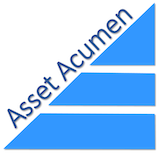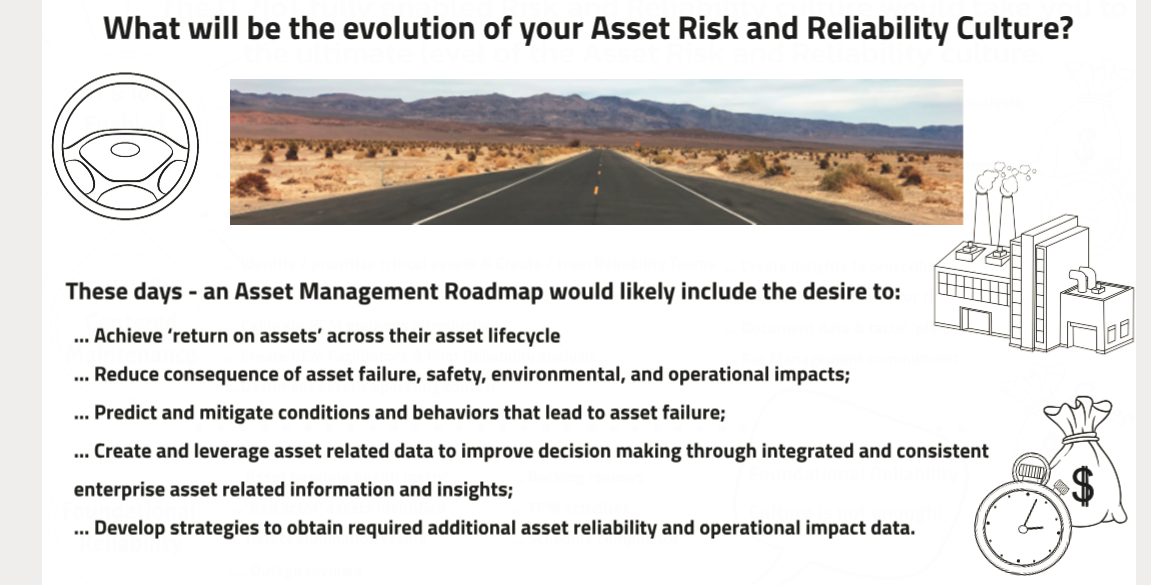What will be the evolution of your Asset Risk and Reliability culture?
Companies purchase assets to create ‘value’. This ‘value’ is why the enterprise strategically exists in their market.
Asset Management has always been about leveraging people, process and technology to keep an organization’s assets running. That certainly is true when working to ensure that the procured assets perform as they were designed to perform when implemented.
Corporate leadership want their assets to perform ‘as designed’ to meet their invested commitments.

These days – an Asset Management Roadmap would likely include the desire to achieve optimal ‘return on assets’ across their asset lifecycle. To accomplish this ROA, they will need a ‘Reliability culture’ that provides the ability to:
- Reduce consequence of asset failure, safety, environmental, and operational impacts;
- Predict and mitigate conditions and behaviors that lead to asset failure;
- Create and leverage asset related data to improve decision making through integrated and consistent enterprise asset related information and insights; and
- Develop strategies to obtain required additional asset reliability and operational impact data.
Where is your organization in the pursuit of these needed Asset Reliability cultural pursuits?
Are you:
- Maintaining (or defending) a Foundational Approach to Asset Reliability?
- Working a Reliability Centered Maintenance (RCM) methodology / discipline?
- Leveraging a fully integrated and automated data analytics approach to Asset Reliability?
Or some – subset – of the above in loose combination.
Many well established and traditional organizations leverage the best intentions of their maintenance staff to ‘keep the operation going’ and track their progress through an existing Enterprise Asset Management (EAM) solution.
A Foundational Approach to Asset Reliability
A Foundational Asset Reliability program could be the first step you take to drive your Risk and Reliability culture.
I would suggest the term ‘foundational’ should be in the title even though for many organizations this requires a lot of discipline to maintain in a corporate-wide Reliability culture. The Foundational activity introduces a Reliability mindset but will not address the growing ROA and Reliability culture needs listed earlier.
An example of a foundational approach – “Asset Reliability” could be for many leading Maintenance teams – a discipline that includes:
- Keeping their planning and scheduling and related backlogs well managed;
- Challenging missed scheduled activities;
- Identifying ‘bad actor’ assets and addressing with maintenance tactical mitigations;
- Creating an asset baseline health metric;
- Creating ‘defect elimination’ teams;
- Performing ‘lessons learned on recent urgent/critical outages;
- Adjusting current tactics and maintenance plans; and
- Encouraging empowered Total Productive Maintenance (TPM) activities.
These are all good actions, although, perhaps not enough of the good actions an organization needs to take to maintain their asset reliability. By the list suggested above all of these activities require some history to execute.
When steering your business by only looking in your past – How many critical asset failures can you absorb before your business is critically impacted?
None of these Foundational Reliability actions ‘proactively’ challenge whether their maintenance planned tactics are the best for their critical assets specific to each asset’s operating context.
More is needed to achieve the desired ROA across an assets’ life-cycle. Here is where a formal Reliability Centered Maintenance (RCM) program likely should be injected (or ideally before this point here).
A Reliability Centered Maintenance (RCM) approach to Asset Reliability
An RCM program could be the second step you take to drive your Risk and Reliability culture forward.
A formal RCM program approach features:
- Preserving system functions as the primary objective;
- Identifying failure modes that can impact system failures;
- Prioritizing Failure Modes; and
- Finding solutions to manage the likelihood of occurrence or the consequences of the failure modes (or both through evaluating the inherent risk associated with owning and operating the assets).
A formal RCM program can include:
- Identifying and prioritizing critical assets for a Risk and Reliability assessment;
- Creating Reliability Teams with Maintenance, Operations and Design Engineering personnel;
- Calibrating the standards (through Training) for the Reliability Teams on RCM method introductions;
- Creating RCM Facilitators in your company;
- Piloting a few Reliability analysis (with FMEA outputs);
- Creating the knowledge and related data to identify the best tactic for each asset’s operating context;
- Identifying the thresholds for triggering notifications and mitigation tactics;
- Documenting the reliability data & tactic ‘plans’ in your EAM solution; and
- Securing Management commitment to the new plans.
In simple speak:
- a Foundational Reliability approach leaves you with only the EAM solution to perform maintenance ‘efficiently’ and history to prioritize past activity;
- a proactive RCM analysis provides you with – the above plus – the most ‘effective maintenance tactic (and frequency)’ to load into your EAM solution to execute ‘efficiently’;
A well-executed RCM culture will see benefits from their asset management programs such as:
| Improved Productivity: | Increased Maintenance Effectiveness: | Reduced Costs: |
|
|
|
Remember, Asset Management is not all about reducing Maintenance costs but about driving ‘asset value!’
So, what is next?
If a proactive RCM analysis provides you with the most ‘effective maintenance tactic (and frequency)’ to load into your EAM solution so that you can execute the chosen tactic ‘efficiently’: how can we use this new data to optimally schedule maintenance aligned with Operations and external influences such as weather?
IT / IoT / AI interconnectivity to drive Reliability and ROA
The notion of Asset Performance Management (APM), Internet of Things (IoT) interconnectivity when well supported by our IT colleagues and Artificial Intelligence (AI) has become the next bastion of Asset Optimization and Risk and Reliability Management tools and methods.
These tools and methods will not work well without the foundational Reliability culture and the clear understanding, disciplines, habits, and data insights that come from a fully executed RCM program (Level 1 & 2).
IT / IoT / AI Reliability scope can include:
- Integrating the Asset Health, Transaction & Reliability threshold data;
- Including market demands and other external data (e.g. weather) to influence asset maintenance schedules;
- Preparing to leverage IT and Artificial Intelligence (AI) to automate a first pass of an RCM analysis; and
- Supporting a Reliability culture that is automated to drive asset ‘value’ through strategic operational optimization.
With an RCM analysis culture creating the data to support an IT /IoT culture you now have your Risk and Reliability culture that drives prescriptive operational optimization in an automated format. The benefits of such an elevated Reliability culture.
The IT /IoT /AI fully enabled Risk and Reliability culture would take you to the ultimate (and third) level of the Asset Risk and Reliability culture to a notional automated and prescriptive asset and operational optimization!
What will be the evolution of an Asset Risk and Reliability culture?
The answer is up to you and your colleagues as you work to drive ‘value’ from your assets by leveraging your Reliability culture.
If you are defending the Foundational level only you are destined to stay there.
Your company’s evolution will not expand without the commitment to RCM and your corporate community asset focus knowledge and related data insights that are gained.
Without both the Foundational and RCM well intrenched in your culture – looking to evolve to an IT/ IoT/automated enabled Reliability level will like just be a few data scientists reviewing poorly understood data against undefined asset operating contexts, trying to turn this poor base of data to information then to insights and ultimately to poorly curated decisions.
Imagine the benefits to your organization when you evolve your Risk and Reliability culture from:
- A Foundational Reliability approach leaves you with only the EAM solution to perform maintenance ‘efficiently’ and history to prioritize from past activity,
TO…
- The proactive RCM analysis provides you with the most ‘effective maintenance tactic (and frequency)’ to load into your EAM solution to execute ‘efficiently’,
AND with IT support…
- A Reliability culture that is IT and IoT enabled and automated to drive asset ‘value’ through strategic operational alignment and optimization into your company’s value chain.
If you are still defending the elements of only a Foundational Reliability program in your company, think of investing in – and evolving – your Risk and Reliability culture investment to drive the critical asset value in why your organization exists in the markets it serves.
You owe it to your self and your company’s ability to compete in current and future markets.
References:
Reliability Centered Maintenance (RCM) Culture Evolution, Presentation, Don Barry – January 2021
UofT Physical Asset Management Program, Training, Don Barry – November 2020
www.Aladon.com website – January 2021

